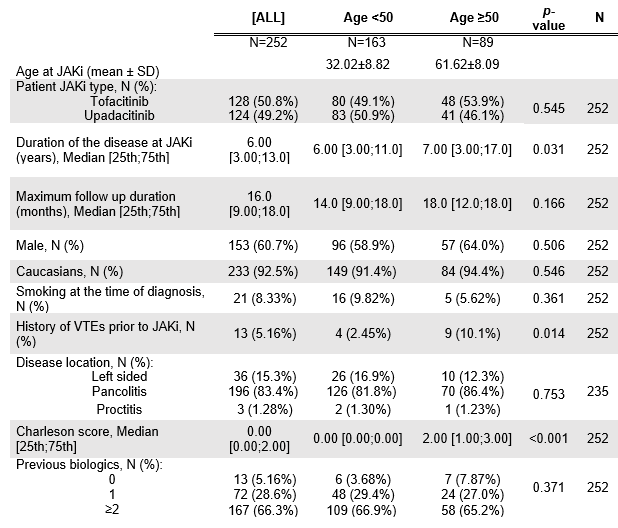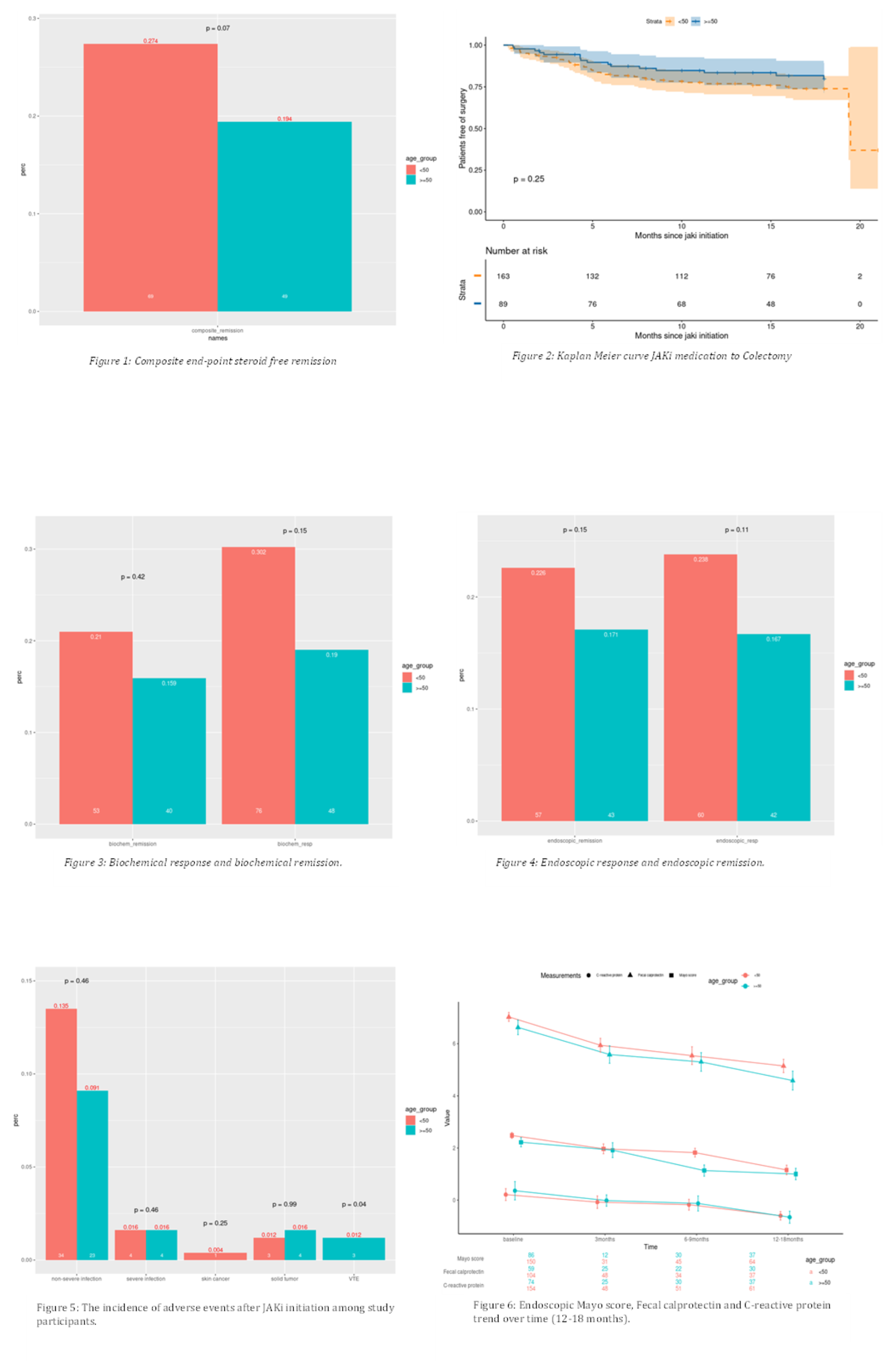Sunday Poster Session
Category: IBD
P1020 - Clinical Outcome, Colectomy and VTE Rates in Elderly With Ulcerative Colitis Treated With JAK Inhibitors: A Real-World Analysis
Sunday, October 26, 2025
3:30 PM - 7:00 PM MT
Location: Exhibit Hall
- TJ
Tasneem Jamal Al-Din, MD
Cleveland Clinic Florida
Weston, FL
Presenting Author(s)
Tasneem Jamal Al-Din, MD, Ashraf Almomani, MD, Asad Ur Rahman, MD, Fernando Castro, MD
Cleveland Clinic Florida, Weston, FL
Introduction: JAK inhibitors (JAKi) are increasingly used for treating moderate to severe ulcerative colitis (UC). However, their long-term efficacy and colectomy risk in older adults remain unclear due to underrepresentation in clinical trials.
Methods: We conducted a multicenter retrospective cohort study of UC patients treated with JAKi at tertiary centers (OH, FL) from Jan 2018–Aug 2023. Patients were classified as young (< 50) or elderly (≥50 years) at JAKi initiation. Exclusion criteria included Crohn’s disease, other colitis etiologies, biologic combination therapy, or missing outcomes.
The primary outcomes were composite end-point remission at 52 weeks [defined as steroid-free clinical remission (SFR) (PRO2 score) in addition to biochemical and/or endoscopic remission], and colectomy at last follow up. Therapy switch prior to 52 weeks due to clinical worsening was considered treatment failure. Secondary outcomes included biochemical response [50% reduction of the CRP and/or fecal calprotectin], biochemical remission, endoscopic response [1 point reduction in Endoscopic Mayo Score, EMS] and endoscopic remission [EMS 0-1] and adverse events, particularly venous thromboembolism (VTE).
Results: Of 1565 screened, 252 patients met inclusion [163 young, 89 elderly]. The baseline characteristics of the study population were obtained (Table1). Mean age at JAKi was 61.6 vs. 32.0 years in elderly vs. young groups. Charlson comorbidity index and baseline VTE rates were higher in the elderly (median 2vs.0; 5.2%vs. 2.5%). Disease duration, baseline severity, location, and follow-up length were similar. SFR was achieved more in the young (27.4%vs.19.4%; p=0.07) with no significant difference in colectomy rates (Figures1-2). Secondary outcomes, including safety profiles, were also comparable except for a higher VTEs rate among the elderly population (p= 0.04) (Figures3-5). Additionally, the endoscopic and biochemical inflammatory markers followed similar trends in both groups (figure6).
Discussion: This is the largest real-world cohort comparing JAKi outcomes in elderly vs. younger UC patients. Despite older age and higher baseline comorbidities, elderly patients achieved similar remission and colectomy rates at 52 weeks. However, an increase in the VTE was noted among elderly, which could be explained by higher rates of baseline VTE in that population.

Figure: Table 1: Baseline Characteristics of Study Participants

Figure: Figures 1-6
Disclosures:
Tasneem Jamal Al-Din indicated no relevant financial relationships.
Ashraf Almomani indicated no relevant financial relationships.
Asad Ur Rahman: Abbvie Inc – Speakers Bureau.
Fernando Castro indicated no relevant financial relationships.
Tasneem Jamal Al-Din, MD, Ashraf Almomani, MD, Asad Ur Rahman, MD, Fernando Castro, MD. P1020 - Clinical Outcome, Colectomy and VTE Rates in Elderly With Ulcerative Colitis Treated With JAK Inhibitors: A Real-World Analysis, ACG 2025 Annual Scientific Meeting Abstracts. Phoenix, AZ: American College of Gastroenterology.
Cleveland Clinic Florida, Weston, FL
Introduction: JAK inhibitors (JAKi) are increasingly used for treating moderate to severe ulcerative colitis (UC). However, their long-term efficacy and colectomy risk in older adults remain unclear due to underrepresentation in clinical trials.
Methods: We conducted a multicenter retrospective cohort study of UC patients treated with JAKi at tertiary centers (OH, FL) from Jan 2018–Aug 2023. Patients were classified as young (< 50) or elderly (≥50 years) at JAKi initiation. Exclusion criteria included Crohn’s disease, other colitis etiologies, biologic combination therapy, or missing outcomes.
The primary outcomes were composite end-point remission at 52 weeks [defined as steroid-free clinical remission (SFR) (PRO2 score) in addition to biochemical and/or endoscopic remission], and colectomy at last follow up. Therapy switch prior to 52 weeks due to clinical worsening was considered treatment failure. Secondary outcomes included biochemical response [50% reduction of the CRP and/or fecal calprotectin], biochemical remission, endoscopic response [1 point reduction in Endoscopic Mayo Score, EMS] and endoscopic remission [EMS 0-1] and adverse events, particularly venous thromboembolism (VTE).
Results: Of 1565 screened, 252 patients met inclusion [163 young, 89 elderly]. The baseline characteristics of the study population were obtained (Table1). Mean age at JAKi was 61.6 vs. 32.0 years in elderly vs. young groups. Charlson comorbidity index and baseline VTE rates were higher in the elderly (median 2vs.0; 5.2%vs. 2.5%). Disease duration, baseline severity, location, and follow-up length were similar. SFR was achieved more in the young (27.4%vs.19.4%; p=0.07) with no significant difference in colectomy rates (Figures1-2). Secondary outcomes, including safety profiles, were also comparable except for a higher VTEs rate among the elderly population (p= 0.04) (Figures3-5). Additionally, the endoscopic and biochemical inflammatory markers followed similar trends in both groups (figure6).
Discussion: This is the largest real-world cohort comparing JAKi outcomes in elderly vs. younger UC patients. Despite older age and higher baseline comorbidities, elderly patients achieved similar remission and colectomy rates at 52 weeks. However, an increase in the VTE was noted among elderly, which could be explained by higher rates of baseline VTE in that population.

Figure: Table 1: Baseline Characteristics of Study Participants

Figure: Figures 1-6
Disclosures:
Tasneem Jamal Al-Din indicated no relevant financial relationships.
Ashraf Almomani indicated no relevant financial relationships.
Asad Ur Rahman: Abbvie Inc – Speakers Bureau.
Fernando Castro indicated no relevant financial relationships.
Tasneem Jamal Al-Din, MD, Ashraf Almomani, MD, Asad Ur Rahman, MD, Fernando Castro, MD. P1020 - Clinical Outcome, Colectomy and VTE Rates in Elderly With Ulcerative Colitis Treated With JAK Inhibitors: A Real-World Analysis, ACG 2025 Annual Scientific Meeting Abstracts. Phoenix, AZ: American College of Gastroenterology.
